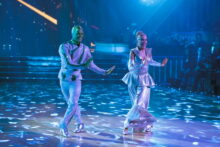The Real Reason Why Lifts Are Now Banned on ‘Dancing With The Stars’
 ABC/Christopher Willard
ABC/Christopher Willard Reading Time: 3 minutes
There’s one rule on Dancing With The Stars that has left fans and contestants scratching their heads: the lift rule. Judge Carrie Ann Inaba has often been the bearer of news when it comes to this particular rule. But what exactly constitutes a lift in ballroom dancing, and why is it such a big deal on the show?
What is The Lift Rule on Dancing With The Stars
Season 32 of Dancing With The Stars is officially in full swing, and we’ve already seen a few, pretty impressive lifts. Although the show has changed a bit since Tyra Banks departure, and Len Goodman’s death, one thing that remains consistent, the DWTS lift rule. Even though the judges have yet to mention the rule, we’re sure it’ll come up sometime this season.
While discussing the lift rule on Dancing With The Stars, we’ll be referencing previous seasons of the show, since judges have yet to comment on lifts in Season 32.
In 2020, Carrie Ann Inaba deducted a point during the show’s premiere. During NFL player Vernon Davis and Peta Murgatroyd’s first routine, the pair performed a foxtrot, which included a lift. This raised eyebrows, especially after TV personality Jeannie Mai and Brandon Armstrong‘s salsa routine included an impressive lift.
To clear the confusion, let’s break it down simply: lifts are generally not allowed in Ballroom and Latin dances on the show. Inaba explained in a 2017 Facebook post that this rule aligns with the National Dance Council of America’s guidelines. To be clear, a lift is defined as, any movement where one dancer has both feet off the floor with their partner’s assistance.
Now, why are lifts prohibited in the first place? Inaba outlined two key reasons. Firstly, it’s about keeping DWTS in line with the spirit of true ballroom competitions. Secondly, it’s about fairness. The show features contestants of varying ages and fitness levels, and not everyone can safely execute lifts. Allowing lifts could give younger competitors an unfair advantage over older ones, it also compromises the authenticity of the dances.
Lifts Are Allowed to Some Extent
With everything being said, there’s a twist in this story. Major lifts are allowed, but it depends on the style of dance being performed. Over the years, DWTS has expanded its repertoire to include various dance styles such as the Jitterbug, Argentine Tango, Charleston, Salsa, Jazz, and Contemporary, where lifts are permissible.
Despite this, the original dance styles featured on the show, like the Rumba, Cha Cha, Jive, Paso Doble, Samba, Tango, Waltz, Viennese Waltz, Foxtrot, and Quickstep, are still strictly no-lift zones.
So, when you’re watching the show and a lift occurs, don’t be taken by surprise. Pay attention to the style of dance being performed. If it falls into the “no lifts allowed” category, like the foxtrot, expect points to be deducted. If it’s one of the styles where lifts are permitted, like the salsa, then you’re in the clear.














